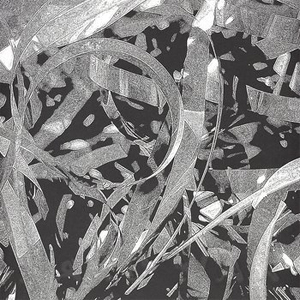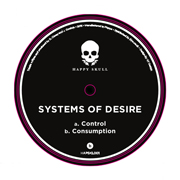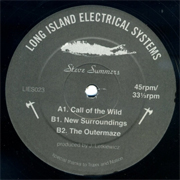A few things I’ve included in this colossal edition of Hyperspecific (usual drill, make yourself a cup of tea, take a 15 minute break every hour, etc) have been around for a little while. You could call it making up for lost time – and admittedly it is, partly because I’ve been so busy that I haven’t found the time to write as many of these columns as I’d have liked this year – but it’s mostly because some of these releases have taken a while to fully digest. Jam City’s free hard drive deep delve from a couple of months back, for example, contains so much material that the only real way to absorb it all is in bitesize chunks in among other listening, for fear of becoming hopelessly and permanently sucked into its synthetic sci-fi cityscape.
In the time since the last edition I had the great pleasure to be invited back onto Rinse FM again, to play some music alongside Casper Clark on the BleeD show. Given that I’ve been listening to Rinse for years, have written sleevenotes for their compilations and mixes, and the styles they’ve fostered formed the backbone of my early dance music excursions, it’s needless to say an honour to be able to add even a tiny transmission of my own to the station’s history. If you’re interested in taking a listen, you can find last week’s show – which features a banging guest mix from Dro Carey, some synth-driven oddness and scuzzy dance music – available for stream/download here.
It’s been a recurring theme in this column over the past year or so, but I’ve been feeling swamped by the sheer amount of music I feel I should be keeping up with in order to make sure Hyperspecific stays (relatively) cutting edge. Perhaps that’s just because I’m being sent more by labels and artists, or because I’m trying to keep my toes dipped in several scenes at once rather than honing in on one (the latter of which felt easier even a couple of years ago – dance music at the moment feels less like a series of defined lineages and more a treacherous spider web of cross-links and connections within which to get entangled). So instead of trying to be comprehensive, I’ve endeavored for each section of this edition to focus on something completely separate, something I’ve been enjoying from a particular section of the dance music world, from the Bristolian echo chamber to Philadelphia technoise. Enjoy!
Morphosis – Dismantle/Music For Vampyr
(Honest Jon’s)
Metasplice – Infratracts
(Morphine)
_moonraker – Lowjit Vagrants
(Trilogy Tapes)

But as of late the output of his label Morphine has become progressively wilder and more in thrall to the untamed sonics of noise music, and the influence of jazz and early electronic music on his work is becoming more pronounced than ever before. Indeed, when I interviewed Beaini (pictured, top) earlier this year for The Wire he expressed a love and devotion to the work of Sun Ra, and his side projects extend outwards to jazz and krautrock-influenced percussive fury (the Upperground Orchestra, whom I’ve written about in this column before) and a recent and marvelous noise/jazz album under his own name, Albidaya, inspired by the traditional musics of his youth in Lebanon.
Morphosis – ‘Dismantle’
This new double EP for Honest Jon’s sounds like he’s thrown his original masters into a nuclear reactor and is bearing witness to their gradual decay. In the end, on ‘Dismantle’ and ‘Tamrat Version’, all that’s left is a skeleton of rhythm, still grinding away at the core even as all extraneous material sloughs away. The fact that you can still shake a leg to both, however, makes them enthralling examples of just how far you can push so-called ‘dance’ music without losing grip of it entirely. ‘Music For Vampyr’s three parts intentionally land on the other side of that divide – they’re composed of similar assemblies of heavily effected, distorted organ tones, but were written not as club music, but to soundtrack Dreyer’s film of the same name. It’s as creepy as Vampyr itself, all unresolved tension and extended dissonances that gradually builds to a moment of glorious release ten minutes through ‘The Arrival Extended’. When a series of sustained cleaner notes blossom into life, it’s like the sun breaking through the clouds.
Degraded textures and a near-subliminal techno pulse is something Beaini’s latest material shares with Philadelphia’s Metasplice, whom he introduced to the world last year with the punishing Topographical Interference EP on Morphine. The duo’s fantastic Infratracts debut album sneaked out last month with a bare minimum of fanfare, and it’s an intense, physically wearing and challenging listen even by the standards of their previous material. You can learn a lot about Metasplice through their track titles. ‘Thermite Jack’, ‘Arterial Protocol’, ‘Prismatic Sway’, ‘Dioxination’ – all suggest unholy and painful synergies of organic systems with mechanical processes, human bodies jacked directly into hard circuitry and pumped full of chemical blood.
The duo’s music embodies this unsettling image. Somewhere deep within it’s powered along by rhythms primed to interface with the human body, but its textures are hard, brittle and distinctly alien. ‘IV Phenol’ is my favourite, in part just because it’s such a deliciously sadistic title, but mostly because the track itself offers such a brutal auditory approximation of how it might feel to have bleach injected directly into your veins: an all-encompassing, ultra-distorted low-end roar that wipes out any other external sensations, wracked by needle-sharp, burning high frequencies that arrive in rhythmic bursts, intensifying then diminishing the pain to the pulse of your weakening heartbeat. Bracing stuff.
On the whole Infratracts dials down the more overt techno flirtations of their earlier Morphine EPs, instead concentrating on hacking away at your nerves until you’re left prone and shuddering – ‘Dioxination’s high frequency shards sparkle like razor-edged silicon crystals on the surface of an alien world, both dazzling and deadly, while album highlight ‘Concrode’ is an utterly unforgiving but strangely beautiful eight minutes of sandblasted high-end drone. The album was pressed in a fairly small vinyl run but a few smaller online stockists still seem to have copies, and if you’re in any way interested in electronic or extreme music in general I’d strongly recommend grabbing yourself a copy.
Metasplice – ‘IV Phenol’
My discovery of Metasplice last year offered a glimpse into the noise/improv electronics scene in Philadelphia, which seems to be thriving away from the world’s wider attention. Metasplice’s kenneth lay plays alongside veteran Buchla synth improviser Charles Cohen in the duo Color Is Luxury, and also forms one half of _moonraker alongside Jason Carr. Following on from two great 12″s for Philadelphia label Great Circles, they’ve been snapped up for the Lowjit Vagrants EP by Will Bankhead’s Trilogy Tapes, thus drawing them into a wider techno/house dialogue alongside fellow TTT signings like MM/KM, Anthony Naples and Tuff Sherm. And indeed, although hard-edged, cosmic tonalities mark out _moonraker’s work – as the project’s title suggests, this is very much an off-world-colonies, terraforming sort of affair – its techno and electro-indebted rhythms are more overtly targeted at the dancefloor than Metasplice’s aural battery.
‘Oronimbus’ in particular is one of the most wonderfully bizarre club tracks I’ve heard for ages, its space whale theremin song calling out above a bed of swung percussion and squelchy bass that suggests some weaponised fusion of UK garage and early acid house. By all rights it shouldn’t hold together but somehow does, and as a result ends up tripping through new territories entirely. The rest of the EP is marginally more straightforward, but no less majestic – a springy electro clip on ‘Plot Query’, more muffled clouds of interstellar dust on ‘Cyan Lean’. Like Metasplice and Morphosis, the duo utilise noise and improvisational techniques to plot trajectories to the farthest reaches of the techno cosmos, aiming towards areas of club music space we haven’t even dreamed of reaching yet. As Ra himself might have put it, “there are other worlds they have not told you of”.
Kowton – Shuffle Good
(Boomkat Editions)
Systems Of Desire – Consumption/Control
(Happy Skull)

Shuffle Good, though, feels like a slight return, away from the overt rudeness of his latest material and back to the creepy, depth-charged slow-house of his earlier 12"s for Idle Hands. The title track drags itself along at glacial pace, while sticky sub bass slugs you repeatedly round the chops, like being beaten to the ground with chunks of half-melted tarmac. I love Kowton’s music for exactly the same reason I adore Peverelist’s – it takes tempos and rhythmic tropes we’ve come to associate with contemporary techno and processes them through a sound system culture filter. ‘EFX01’, in fact, sounds like he’s used the mixing desk to dub out one of his house tracks until all that’s left is the atmosphere that normally floods the background. It hangs stifling and heavy in the air, like a fug of weed smoke and booze drifting along Stokes Croft in the post-club, pre-sunlight hours.

Jam City – Special Trash, Offcuts, Memories 2009-2011
(free download)

However, the drip feed of new music from ongoing artists participating in that narrative – usually via 12"s and unreleased tracks that crop up in mixes or on the radio – tends to mask the process going on behind the scenes, offering only brief insights into how their music develops over time. Especially in the case of someone like Jack Latham, aka Jam City, whose approach has taken a dramatic stylistic jump with each release – from fuzzed-out carnivalesque house to wonky hip-hop, juddering techno and the chrome-and-glass slickness of last year’s Classical Curves album – being given access to a massive archive of unreleased, embryonic material offers a valuable means of joining the dots. And, given that Latham has established himself as one of the most innovative and important producers to emerge from the post-dubstep milieu, perhaps even some insight into the processes that drive the development of the scene on a macro level.
There’s plenty of dot-joining to be found across the two zip files of Special Trash, Offcuts, Memories 2009-2011, not least of which proof that the shimmering, translucent beats of Classical Curves didn’t simply emerge fully formed out of a vacuum (which, if you’d only been listening to his records from a year or two beforehand, you might well have imagined). If the title of ‘Banish Him (2009 Mix)’ is to be believed, he’s been honing that particular strain of metallic broken techno since around the same time of his debut 12". Its opening minutes trace a rocket fueled ascent right up to the edge of the stratosphere, while kicks that lag slightly behind hi-hats lend a sense of drag, as though it’s battling to reach the peak of its arc. Once it arrives it immediately crashes back down to earth in a flurry of grimey bass boinks.
Others, too, possess the rollercoasting, five-into-four kickdrum/hi-hat pattern that’s become an established trait of much post-dubstep UK dance (highlighted in this fascinating analysis by Adam Harper). With their offbeat hi-hat ticks and breakneck forward drive, ‘Gee’ and ‘In The Park II’, for example, are technoid in shape, but an additional low-end kick in each bar adds a crucial extra kink. Part steppers’ skank, part limb-flexing garage swing, as a dancer it feels like you’re being dragged along by the scruff of the neck into each successive bar, and as such it’s near-impossible to resist.
Lots of Special Trash is sketchlike material that plays almost like a study for the finished product, and indeed many of the second zip file’s tracks feel markedly less tooled for clubs, instead exploring icy ambience. But the more completed, ‘floor-ready stuff here highlights just how virtuosic he’s capable of being. Latham daubs sonic matter across his tracks with the economy and seemingly casual precision of the master Chinese calligrapher: not a drop wasted, each line, point and splash beautifully weighted, and each absolutely fizzling with energy. By all rights ‘In The Park’, one of my favourites here, should feel cluttered – there’s lots going on at any given moment – but its Zomby-esque pirouetting melody lines are set in so much space as to feel near weightless.
Indeed, despite frequently hitting with all the force of a wrecking ball, listen closely to Latham’s tracks and they’re often almost completely transparent – each hit of drums or bass and each tiny rhythmic inflection is clearly audible even when arrangements are at their busiest, a trick that sounds equally inspired by the sleek, frosty minimalism of early grime and the futuristic urban architectures of Jeff Mills. It lays bare their intrinsic strangeness, a reminder that while Jam City’s tracks pack one set of system shocks on a dancefloor, outside that one context they’re capable of delivering many others.
You can download Special Trash, Offcuts, Memories 2009-2011 here – Part 1 and Part 2
Steve Summers – The Outermaze
(L.I.E.S)
Terekke – YYYYYYY
(L.I.E.S)
Joey Anderson – Above The Cherry Moon
(Avenue 66)

Given the overlap between its tracks it’s tough to select highlights, though the John Carpenter-esque chug of ‘Call Of The Wild’ in particular toes a marvelous line between rabbit-in-the-headlights dread and glittering cave rave funk. What’s so enjoyable about Summers’ stuff is how distinctly Stateside it feels, without quite falling into any pre-existing US dance music lineage. Its lucid sound nods far more towards Detroit than any of the dubbier fare that’s emerged from our side of the Atlantic, but it’s harsher and more oppressive, as if rather than being inspired by industrial decline it’s dealing with something still more terminal – a planet whose ecology is wilting under human pressure, and a population slowly eroding itself away through conflict and pollution, Children Of Men style. And, as industrial techno and the most brusque minimal have shown us time and again, what can be better an incitement to dance than the certainty of doom to come?
Steve Summers – ‘The Outermaze’
Upon its emergence into wider dance music consciousness last year, L.I.E.S turned heads for a number of reasons, not least of which the uniformly solid quality of its release schedule. But for myself at least, and I’ll wager for many others, most surprising was the way that Morelli had apparently managed to tap a secret and extraordinarily rich seam of underground US house and techno that barely anyone in the wider world was even aware existed. For a while almost every L.I.E.S release came from a hitherto unknown artist, and even now, with increased attention on the label, that’s barely changed.

Terekke – ‘Bank 3’
I’ve never been to New York so I can’t possibly claim to be basing this on anything other than than vague, distant guesswork, but from afar it seems that the L.I.E.S crew exist in a slightly different circle to the other overlapping house scenes within the city. (I’m prepared to be wrong on this, feel free to call me out if necessary.) This other side – the one showcased on Levon Vincent’s fabric mix from last year – feels different in spirit, with artists like DJ Qu and Fred P as well as Vincent himself writing music that draws dancers along psychologically heavier, almost oppressively hypnotic trajectories.

‘Auset’, the B-side to new 12" Above The Cherry Moon, is a perfect example: its harsh, jagged synth lines and mechanical piston pump rhythm simply scream out for a hi-hat to kick them into overdrive, but they’re denied that indulgence, instead left to chew their way through the midrange like grubs burrowing into an animal carcass. Things get even wilder during its final minutes when synth is replaced with a piano, which noodles around spookily in space for a brief period before vanishing, and bringing everything else with it.
Joey Anderson – ‘Above The Cherry Moon’
Anderson’s tracks can also be almost facetiously difficult to mix, rarely starting on the first beat of the bar and building with such care and patience that they run the risk of dragging momentum to a screeching half if not perfectly controlled. With its beatless opening of furnace-blasted, acidic murk, bringing ‘Above The Cherry Moon’ into play on the dancefloor would be a risky activity; the track itself is a near-fathomless, shadowy wormhole, little other than freaked out vocal proclamations and a monolithic kickdrum to mark the root of its operation. Equally, it’s so heavy and driving a piece of work that I can imagine someone like Vincent managing to twist it into the driving peak of a 3am set, which I suppose goes to show the importance of drafting in a skilled DJ to handle hazardous materials like this.
Hyperspecific returns next month to fulfill all your electronic music needs


